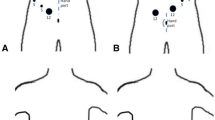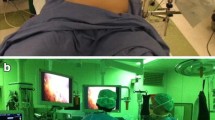Abstract
Background
The correlation between technical feasibility and short-term clinical advantage provided by laparoscopic over open technique for major hepatectomies is unclear. This monocentric retrospective study investigates the possible differences in the benefit provided by minimally invasive approach between left and right hepatectomy, deepening the concept of differential benefit in the setting of anatomical major resections.
Methods
All hemihepatectomies performed from January 2004 to December 2021 were identified in the institutional database. A propensity score method was used to match minimal invasive (MILS) and open pairs in the left hemihepatectomies (LH) and right hemihepatectomies (RH) groups with a 1:1 ratio to adjust any potential selection bias. The differential benefit for left and right hepatectomy provided by laparoscopic over open technique was evaluated in a pure analysis (i.e., including cases converted to open) and a risk-adjusted analysis (i.e., after excluding open conversion from the laparoscopic series).
Results
The analysis of the risk-adjusted differential benefit demonstrated better result of the MILS in the RH group than in the LH group, in terms of blood loss (∆ blood loss − 150 and − 350, respectively; differential benefit: 200 mL, p < 0.05), morbidity (∆ rate of morbidity − 11.3% and − 18.1%, respectively; differential benefit: 6.8%, p < 0.05) and length of stay, LOS (∆ LOS − 1 day and − 3 days, respectively; differential benefit: 2 days, p < 0.05).
Conclusion
While MILS is associated with improved clinical outcomes both in left and right hepatectomy procedures, the greater advantage provided by laparoscopy was documented in patients undergoing right hepatectomy, i.e. for more technically demanding procedures. A MILS program should include the broadest range of liver resections to ensure the full benefits of the laparoscopic technique.




Similar content being viewed by others
References
Ratti F, Cipriani F, Reineke R, Comotti L, Paganelli M, Catena M et al (2018) The clinical and biological impacts of the implementation of fast-track perioperative programs in complex liver resections: a propensity score-based analysis between the open and laparoscopic approaches. Surgery 164(3):395–403
Reddy SK, Tsung A, Geller DA (2011) Laparoscopic liver resection. World J Surg 35(7):1478–1486. https://doi.org/10.1007/s00268-010-0906-5
Buell JF, Cherqui D, Geller DA, O’Rourke N, Iannitti D, Dagher I et al (2009) The international position on laparoscopic liver surgery: the Louisville statement, 2008. Ann Surg 250(5):825–830. https://doi.org/10.1097/sla.0b013e3181b3b2d8
Aldrighetti L, Ratti F, Cillo U, Ferrero A, Ettorre GM, Guglielmi A et al (2017) Diffusion, outcomes and implementation of minimally invasive liver surgery: a snapshot from the I Go MILS (Italian Group of Minimally Invasive Liver Surgery) registry. Updates Surg 69(3):271–283
Fretland AA, Sokolov A, Postriganova N, Kazaryan AM, Pischke SE, Nilsson PH et al (2015) Inflammatory response after laparoscopic versus open resection of colorectal liver metastases: data from the Oslo-CoMet trial. Medicine 94(42):e1786
Cipriani F, Ratti F, Fiorentini G, Reineke R, Aldrighetti L (2021) Systematic review of perioperative and oncologic outcomes of minimally-invasive surgery for hilar cholangiocarcinoma. Updates Surg 73(2):359–377. https://doi.org/10.1007/s13304-021-01006-6
Otsuka Y, Kaneko H, Cleary SP, Buell JF, Cai X, Wakabayashi G (2015) What is the best technique in parenchymal transection in laparoscopic liver resection? Comprehensive review for the clinical question on the 2nd international consensus conference on laparoscopic liver resection. J Hepatobiliary Pancreat Sci 22(5):363–370. https://doi.org/10.1002/jhbp.216
Ratti F, Cipriani F, Fiorentini G, Catena M, Paganelli M, Aldrighetti L (2020) Reappraisal of the advantages of laparoscopic liver resection for intermediate hepatocellular carcinoma within a stage migration perspective: propensity score analysis of the differential benefit. J Hepatobiliary Pancreat Sci 27:510–521
Cipriani F, Ratti F, Paganelli M, Reineke R, Catena M, Aldrighetti L (2019) Laparoscopic or open approaches for posterosuperior and anterolateral liver resections? A propensity score based analysis of the degree of advantage. HPB 21(12):1676–1686. https://doi.org/10.1016/j.hpb.2019.05.006
Vigano L, Laurent A, Tayar C, Tomatis M, Ponti A, Cherqui D (2009) The learning curve in laparoscopic liver resection: improved feasibility and reproducibility. Ann Surg 250(5):772–782. https://doi.org/10.1097/SLA.0b013e3181bd93b2
Aldrighetti L, Cipriani F, Fiorentini G, Catena M, Paganelli M, Ratti F (2019) A stepwise learning curve to define the standard for technical improvement in laparoscopic liver resections: complexity-based analysis in 1032 procedures. Updates Surg 71(2):273–283. https://doi.org/10.1007/s13304-019-00658-9
Fiorentini G, Ratti F, Cipriani F, Quattromani R, Catena M, Paganelli M et al (2021) The SMART-ALPPS protocol: strategy to minimize ALPPS risks by targeting invasiveness. Ann Surg Oncol https://doi.org/10.1245/s10434-021-09711-7
Fiorentini G, Ratti F, Cipriani F, Aldrighetti L (2021) ASO author reflections: the SMART-ALPPS protocol-strategy to minimize ALPPS risks by targeting invasiveness. Ann Surg Oncol https://doi.org/10.1245/s10434-021-09957-1
Fiorentini G, Ratti F, Cipriani F, Marino R, Cerchione R, Catena M et al (2021) Correlation between type of retrieval incision and postoperative outcomes in laparoscopic liver surgery: a critical assessment. J Laparoendosc Adv Surg Tech A 31(4):423–432. https://doi.org/10.1089/lap.2020.0470
Dindo D, Demartines N, Clavien PA (2004) Classification of surgical complications: a new proposal with evaluation in a cohort of 6336 patients and results of a survey. Ann Surg 240:205–213
Tanaka S, Kawaguchi Y, Kubo S, Kanazawa A, Takeda Y, Hirokawa F, Nitta H, Nakajima T, Kaizu T, Kaibori M, Kojima T, Otsuka Y, Fuks D, Hasegawa K, Kokudo N, Kaneko H, Gayet B, Wakabayashi G (2019) Validation of index-based IWATE criteria as an improved difficulty scoring system for laparoscopic liver resection. Surgery 165(4):731–740
Kawaguchi Y, Fuks D, Kokudo N, Gayet B (2018) Difficulty of laparoscopic liver resection: proposal for a new classification. Ann Surg 267(1):13–17. https://doi.org/10.1097/SLA.0000000000002176
Ratti F, Rawashdeh A, Cipriani F, Primrose J, Fiorentini G, Abu Hilal M et al (2021) Intrahepatic cholangiocarcinoma as the new field of implementation of laparoscopic liver resection programs. A comparative propensity score-based analysis of open and laparoscopic liver resections. Surg Endosc 35(4):1851–1862. https://doi.org/10.1007/s00464-020-07588-
Cipriani F, Ratti F, Fiorentini G, Catena M, Paganelli M, Aldrighetti L (2020) Pure laparoscopic right hepatectomy: a risk score for conversion for the paradigm of difficult laparoscopic liver resections. A single centre case series. Int J Surg 82:108
Ratti F, Fiorentini G, Cipriani F, Paganelli M, Catena M, Aldrighetti L (2019) Safety of minimally invasive liver resections during live surgery: a propensity score based assessment. HPB 21(3):328–334. https://doi.org/10.1016/j.hpb.2018.08.015
Halls MC, Berardi G, Cipriani F, Barkhatov L, Lainas P, Harris S et al (2018) Development and validation of a difficulty score to predict intraoperative complications during laparoscopic liver resection. Br J Surg 105(9):1182–1191. https://doi.org/10.1002/bjs.10821
Ratti F, Cipriani F, Fiorentini G, Catena M, Paganelli M, Aldrighetti L (2022) Have we really understood when the efforts of laparoscopic liver resection are justified? A complexity-based appraisal of the differential benefit. Hepatobiliary Surg Nutr 11(3):363–374
Vining CC, Al Abbas AI, Kuchta K, Paterakos P, Choi SH, Talamonti M, Hogg ME (2023) Risk factors and outcomes in patients undergoing minimally invasive hepatectomy with unplanned conversion: a contemporary NSQIP analysis. HPB 25(5):577–588. https://doi.org/10.1016/j.hpb.2023.01.018
Halls MC, Cipriani F, Berardi G, Barkhatov L, Lainas P, Alzoubi M, D’Hondt M, Rotellar F, Dagher I, Aldrighetti L, Troisi RI, Edwin B, Abu HM (2018) Conversion for unfavorable intraoperative events results in significantly worse outcomes during laparoscopic liver resection: lessons learned from a multicenter review of 2861 cases. Ann Surg 268(6):1051–1057. https://doi.org/10.1097/SLA.0000000000002332
Lopez-Lopez V, Linecker M, Cruz J, Brusadin R, Lopez-Conesa A, Machado MA et al (2022) Liver growth prediction in ALPPS—a multicenter analysis from the international ALPPS registry. Liver Int 42:2908
Della Corte A, Fiorentini G, Ratti F, Cipriani F, Canevari C et al (2022) Combining laparoscopic liver partitioning and simultaneous portohepatic venous deprivation for rapid liver hypertrophy. J Vasc Interv Radiol 33(5):525–529
Fiorentini G, Ratti F, Aldrighetti L (2022) Correction to: the LiTOS-approach: liver partitioning and total venous occlusion for staged hepatectomy. J Gastrointest Surg 23:s988
Heil J, Schadde E (2021) Simultaneous portal and hepatic vein embolization before major liver resection. Langenbecks Arch Surg 406(5):1295–1305
Laurent C, Fernandez B, Marichez A, Adam JP, Papadopoulos P, Lapuyade B et al (2020) Radiological simultaneous portohepatic vein embolization (RASPE) before major hepatectomy: a better way to optimize liver hypertrophy compared to portal vein embolization. Ann Surg 272(2):199–205
Korenblik R, Olij B, Aldrighetti LA, Hilal MA, Ahle M, Arslan B et al (2022) Dragon 1 protocol manuscript: training, accreditation, implementation and safety evaluation of portal and hepatic vein embolization (PVE/HVE) to accelerate future liver remnant (FLR) hypertrophy. Cardiovasc Intervent Radiol 45(9):1391–1398
Ratti F, Cipriani F, Ariotti R, Giannone F, Paganelli M, Aldrighetti L (2015) Laparoscopic major hepatectomies: current trends and indications. A comparison with the open technique. Updates Surg 67(2):157–167. https://doi.org/10.1007/s13304-015-0312-5
Author information
Authors and Affiliations
Corresponding author
Ethics declarations
Disclosures
Drs. Marco Maria Pascale, Francesca Ratti Federica Cipriani, Rebecca Marino, Marco Catena, Lucrezia Clocchiatti, Silvia Buonanno, Luca Aldrighetti have no conflicts of interest or financial ties to disclose.
Additional information
Publisher's Note
Springer Nature remains neutral with regard to jurisdictional claims in published maps and institutional affiliations.
Rights and permissions
Springer Nature or its licensor (e.g. a society or other partner) holds exclusive rights to this article under a publishing agreement with the author(s) or other rightsholder(s); author self-archiving of the accepted manuscript version of this article is solely governed by the terms of such publishing agreement and applicable law.
About this article
Cite this article
Pascale, M.M., Ratti, F., Cipriani, F. et al. A “cui prodest” evaluation on the development of a minimally invasive liver surgery program: a differential benefit analysis of open and laparoscopic approach for left and right hemihepatectomies. Surg Endosc 37, 8204–8213 (2023). https://doi.org/10.1007/s00464-023-10382-6
Received:
Accepted:
Published:
Issue Date:
DOI: https://doi.org/10.1007/s00464-023-10382-6




